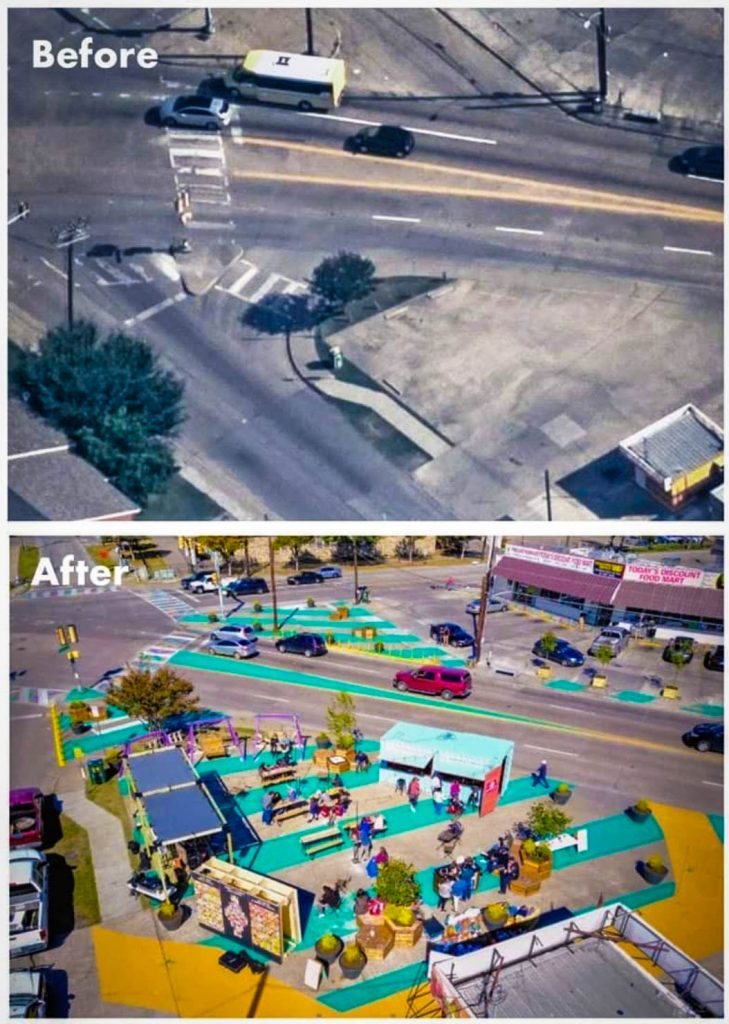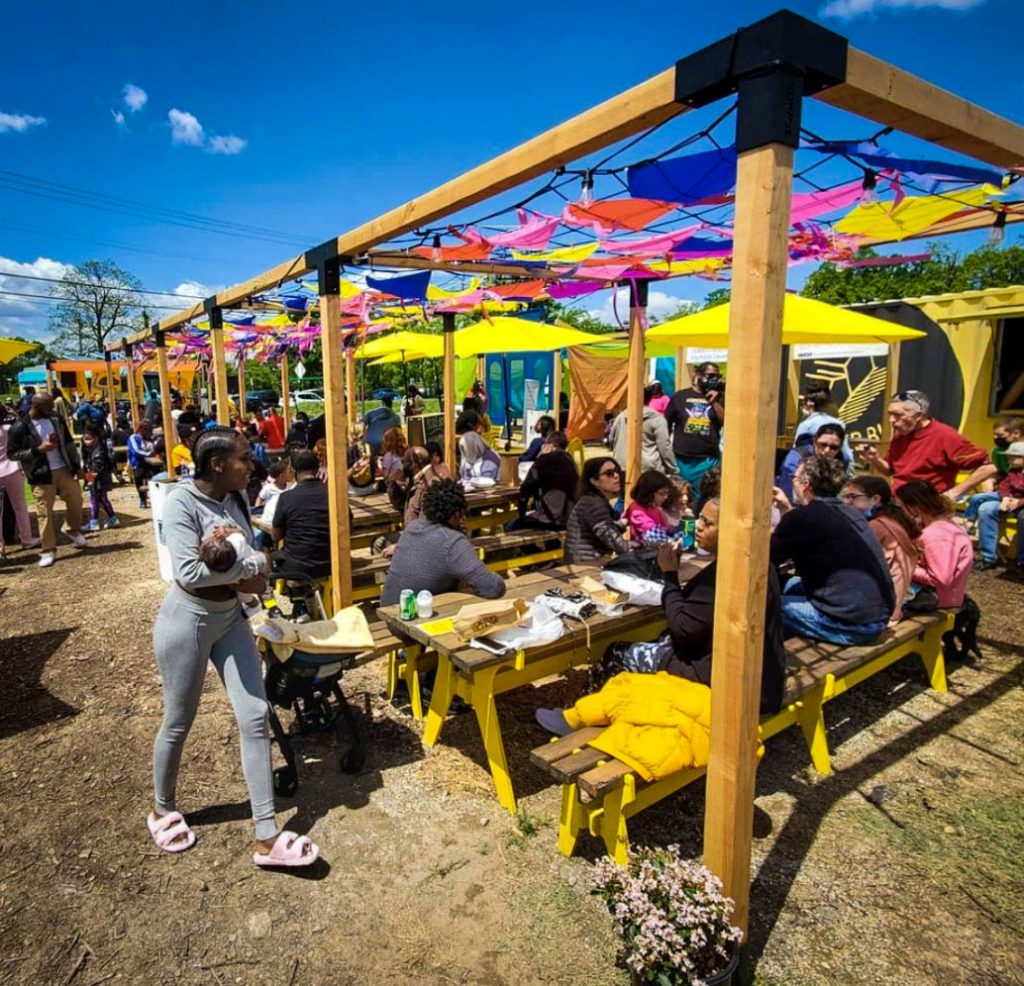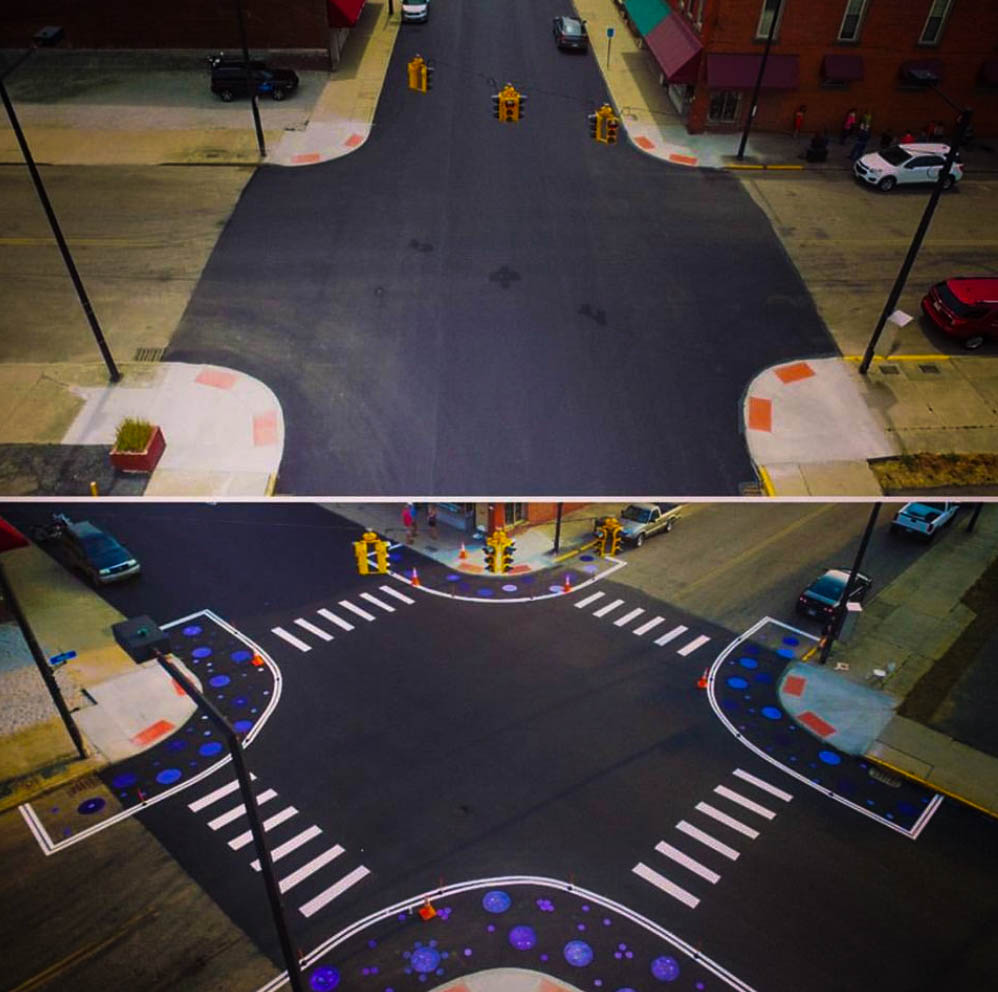Every neighbourhood has the potential to become a wonderful place to live – a city block with vibrant streets, romantic lights, bookstores and cafés! In a lot of communities, this potential is simply too hidden for the residents to see. We talked to CityChanger Jason Roberts, who started his non-profit Better Block to change just that.
Jason Roberts, founder and CEO of the non-profit Better Block, used to be a normal IT guy, living in Dallas, Texas, not paying much attention to Urban Planning and Design. That is until he looked closer at the block he was living in. With a lot of empty buildings, suffrage from blight and disinvestment over the years, the neighbourhood had clearly lost its flair.
Motivated to change the place for the better, Jason went to the people you’d hope to bring change to a city: public officials. But, to his disappointment, “they said it’s going to take years and would cost a lot of money”, Jason recalls. Frustrated but determined, he thought about driving change himself.
Just Do It – the Start of Better Block

Not only was the area Jason was living in suffering from disinvestment, but it was dominated by a three-lane street where cars would highspeed all the time, which is not uncommon in the US inner cities. Sidewalks are thin, and landscaping is removed to give cars as much space as possible.
On a weekend in April 2010, instead of waiting for the city to change things, Jason and his team temporarily turned the three-lane street into a one-lane road and brought back vibrancy: they painted crosswalks, widened the sidewalks, added outdoor seating, and created several small businesses in not used buildings – with success.
“It worked really well the first time, so then we decided to try it again a few months later, and it worked pretty well again. People started asking to do their own projects outside of our area. So, I developed a website and posted a guidebook on how to do that, then it got started spreading incredibly fast afterwards,” Jason recollects. That is how Better Block got started.
Temporary Change for Lasting Impressions

But why put in all this effort for something temporary? – To show what’s possible!
Jason and his team “take a city that’s typically suffering some type of disinvestment or lacks activity and vibrancy”. They talk to the residents, asking them what they wish to change in their neighbourhood.
For one weekend, Jason, his team and the residents turn the neighbourhood into what it could be. With the help of the community, neighbourhoods are given back to the people. They paint bike lanes, build more seating areas, add trees and started local businesses such as bookstores and cafés in buildings that previously were empty.
All of this aiming to show city officials and residents how space could be used better: “We’ll invite city staff and mayors to look at the things happening and see how it’s active and vibrant and start discussing ways to make those things last afterwards.”
Ninety Days of Planning – One Weekend of Joy
Building a Better Block takes a lot of preparation – let’s be frank, it’s a lot to do in a very short period of time. Most projects, from getting hired (now regularly by cities) to the implementation weekend, last about 90 days.
It starts with conversations and gathering information about the neighbourhood. Basically, Jason and his team go to the city and meet with the community. “We’ll bring in everybody we can, so non-profits, residents, small businesses, and start cataloguing empty buildings, looking at streetscapes, start asking questions and do quantitative and qualitative serving analysis.”
After getting an insight into the community and their wishes for change, Jason’s team starts to think about ways to re-design the street spaces, always connected with the neighbourhood, continuously asking for feedback on what they like or dislike.
All these days of planning and back-and-forth-communication result in one week of actually implementing change. Everything gets built and assembled together with the community’s volunteers.
Finally, the project finishes with one weekend where the community can sit back and enjoy the changes in their neighbourhood, evaluate what works and what doesn’t, and appreciate the vibrancy of that weekend with people gathering on the streets, getting coffee in pop-up bars and enjoying a concert in that newfound public space. After that, everything gets taken down, but the impact on the residents will last.
Marrying the Neighbours
Better Blocks was created to improve liveability in neighbourhoods. But what exactly ensures liveability? Whilst talking to Jason, one thing keeps coming up – a sense of community.
Compared to other countries such as Sweden and Denmark, where Jason implemented projects as well, there is a distrust in the government in several US communities. This suspicion is rooted in America’s history of oppression. Hence, the community has played a much bigger role in the US than in European countries but has decreased in recent years, nevertheless.

Creating a sense of community is probably one of the key factors for the success of Better Blocks. The fact that everyone can participate and get something out of it is unique on its own and has a lasting impact. “This event marries a lot of neighbours. Whether it’s painting the streets or planting trees, it’s a bonding kind of activity.”
“And once people are connected, even in that temporary nature, that’s how things transform in neighbourhoods.”
Jason himself has experienced how much change can come by being connected to your neighbours. His favourite project to this day is the first Better Block in his neighbourhood, which has resulted in having his own little restaurant with friends he met during the project. “Those things wouldn’t have happened had I not gotten to meet my community“.
Better Block’s Key for Success and Lasting Change
What makes or breaks a project like this? According to Jason, the temporary nature of the Better Blocks is a key factor for success. Even though we always say change is wonderful – if you’re honest to yourself, just like most people, you are probably afraid of transformation.
When people know the project is only going to be temporary, they tend to be more open to the ideas: It could be horrible, it could be amazing, we don’t know, but it’s just for Saturday and Sunday”.

The fact that everyone can participate and there’s no barrier to participation is a necessity as well. And it proves efficient. When being asked to give examples of the lasting impact the Better Block project had in some neighbourhoods, Jason was quick to name several. In many neighbourhoods, especially the small pop-up businesses become permanent. For some people who always dreamed of owning a bakery, for instance, the project was the chance to test it out.
The bike infrastructure often increases as well, however, “the private sector changes faster than the public realm because the public realm just requires more public funding”. Jason tells us that in some neighbourhoods, nothing changes afterwards in terms of the use of space, but social capital is raised in every project. Moreover, the project inspires many to go into politics: “I see people that were not involved with their local government that run for city council”.
Challenges of a Better Block
One of the biggest challenges Jason faces during a Better Block project is the sad realization that our environment is built for cars. To show the community how the neighbourhood could potentially look like, Jason’s team has to rapidly figure out how to condense it down into an intimate space for people. This is difficult because every area has unique issues; every community is different. That is also the reason why Better Blocks never look the same.
Similarly, when asked what a perfect city block looks like to him, Jason couldn’t just think of one thing – every city has certain blocks that draw Jason’s attention. A specific example would be New Orleans – a perfect mix of density, old and new architecture, and walkable streets. “My dream block has a walkable environment, it feels vibrant, it’s got outdoor markets, it’s got historical light, it’s got romance to it. It just feels alive. It allows human activity to occur”. Sounds like a place we would much like to visit as well.
A Toolbox for Better Blocks: Wikiblocks
Better Blocks have been implemented all over the US. Recently, Jason and his team focused on making the implementation even easier. They created Wikiblock, which is basically a library of outdoor furniture. You can download several designs for free and easily build the desired outdoor furniture yourself.
The non-profit also offers pre-made parklets for easy and quick construction of seating opportunities next to sidewalks. All of these ideas serve the ultimate goal the project has been aiming for all along – getting people to build Better Blocks without Jason’s help: “As I’ve gotten older and gotten to do this more, I get more satisfaction from seeing other people have that switch. That switch, when we start thinking about the built environment, thinking about walkability and how transformative that is on communities.”
Jason’s Advice for CityChangers
What about you? Did you already have that switch? If so and you’re wondering how to start bringing about change, listen to Jason’s advice:
“Just show up. I found that worldwide community engagement has reduced- because of technology and tools out there, we don’t have to gather much. When I started getting involved, I joined every organization I could. I thought it was hard to gain access, but it was actually really easy because most people don’t volunteer.
So just get involved, meet your neighbours, meet your residents, and you’ll make a lot of friends. And then you’ll be in a position where people start asking you, ‘what else should we do?’ Then you start making other changes that you’ve always dreamed of.”
If you can’t get enough of Jason, take a look at his TED talk a few years back, explaining how to build a Better Block.


